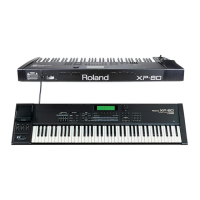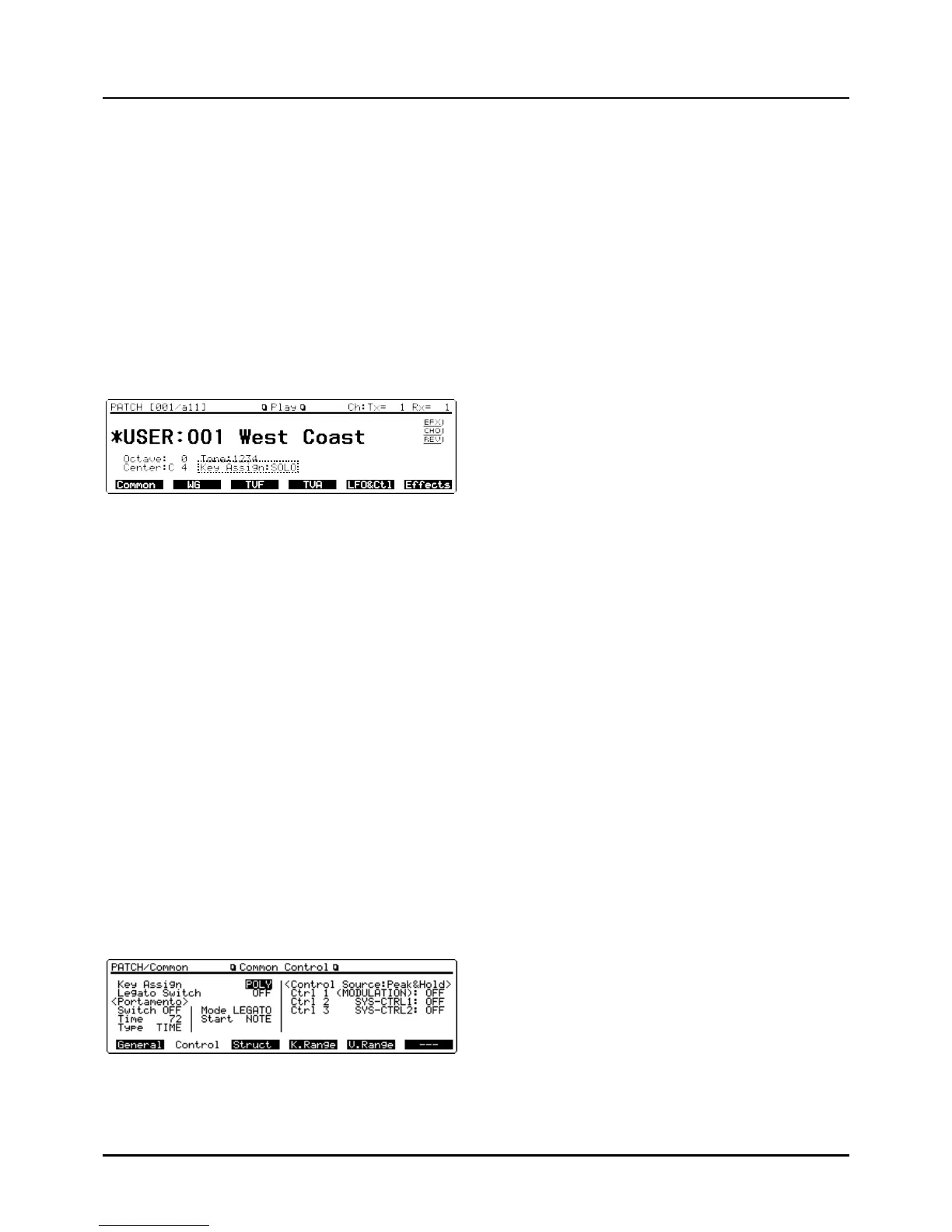28
Playing single notes (Solo)
Normally, the XP-80 allows you to play chords. Pressing
[SOLO] allows performance using single notes. This function
is effective when performing a solo using single-note
Patches like sax and flute.
✳ The Solo function on/off setting can be stored as a part
of each Patch setting using the Key Assign parameter
(PATCH/Common/Common Control).
<Procedure>
❶ Make sure that the Play display (PATCH) is showing.
❷ Press [SOLO] so its indicator lights.
Now you can play a solo.
✳ This setting is also shown for “Key Assign” at the bot-
tom center of the display.
❸ Play the XP-80 keyboard.
✳ If you press [SOLO] when Single Performance is select-
ed, the Solo function can be switched on or off for the
current Part. When Layer Performance is selected, the
Solo function can be switched on or off for the Parts
with the Local Switch parameter (PERFORM/MIDI/
Part MIDI) set ON. If a Rhythm Set is selected, [SOLO]
cannot be turned on.
Creating smooth pitch changes
(Portamento)
Portamento ensures a smooth pitch changeover from one
note to the next note played. When [SOLO] is on (indicator
lights), you can simulate techniques like violin glissandos.
✳ The Portamento function on/off setting can be stored
as a part of each Patch setting using the Switch para-
meter (PATCH/Common/Common Control).
<Procedure>
❶ Make sure that the Play (PATCH) display is showing.
❷ Press [PORTAMENTO]. Its indicator lights.
You’re ready to play portamento.
❸ To adjust portamento, Press [F1] (Common), then [F2]
(Control) to call up the Common Control display
(PATCH/Common).
❹ Move the cursor over to Time, Type, Mode or Start
parameter.
See p.47 for each parameter’s functions.
❺ Turn the VALUE dial or press [INC]/[DEC] to get the
value you want.
❻ Press [EXIT] to return to the Play display (PATCH)
and play.
✳ If you press [PORTAMENTO] when Single
Performance is selected, the Portamento function can
be switched on or off for the current Part. When Layer
Performance is selected, the Portamento function can
be switched on or off for the Parts with the Local
Switch parameter (PERFORM/MIDI/Part MIDI) set
ON. If a Rhythm Set is selected, [PORTAMENTO] can-
not be turned on.
Quick sound character changes
(Sound Palette)
With the four sliders in the Sound Palette section, you can
create sound variations or volume changes in real time.
✳ Sound variations or volume changes made with the
Sound Palette affect only the performance. They have
no effect on current Patch settings. Change the Patch
and these Sound Palette settings will be lost.
✳ The sound character and volume changes created
using the Sound Palette will also be transmitted to the
XP-80’s sequencer and external MIDI devices.
Changing sound characters
<Procedure>
❶ Make sure that the Play display (PATCH) is showing.
❷ Press [FILTER/ENV] and its indicator lights.
❸ Move the sliders while you play to vary the sound.
To modify the brightness, move the CUTOFF slider.
To change resonance, move the RESO. slider.
To change attack time, move the ATTACK slider.
To change decay time, move the DECAY slider.
Changing the volume of each Tone
<Procedure>
❶ Make sure that the Play display (PATCH) is showing.
❷ Press [LEVEL] and its indicator lights.
❸ Move the LEVEL slider as you play the keyboard to
adjust volume as desired.
Sliders 1, 2, 3, and 4 are used to change the volume of Tones
1, 2, 3, and 4, respectively.
Chapter 2. Playing

